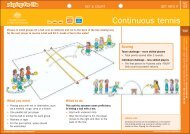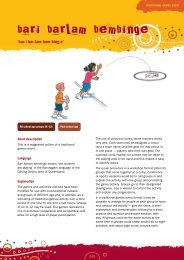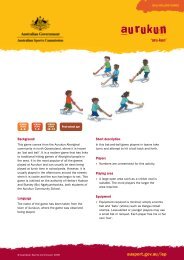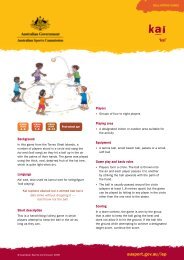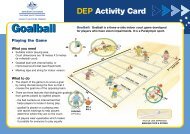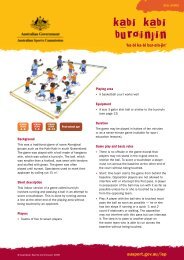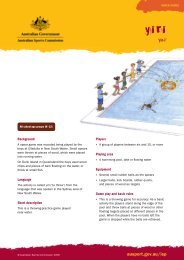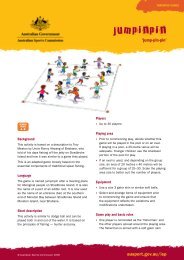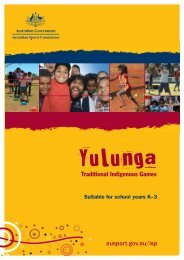the sydney 2000 olympic and paralympic games - Australian Sports ...
the sydney 2000 olympic and paralympic games - Australian Sports ...
the sydney 2000 olympic and paralympic games - Australian Sports ...
You also want an ePaper? Increase the reach of your titles
YUMPU automatically turns print PDFs into web optimized ePapers that Google loves.
PART FOUR : NSW GOVERNMENT AGENCIES GAMES SUPPORT SERVICES<br />
Venue Transport Managers co-ordinated transport services at each venue, working closely with<br />
operational transport staff <strong>and</strong> SOCOG venue staff. This involved meeting <strong>the</strong> different needs of athletes,<br />
team officials, technical officials, spectators, media personnel <strong>and</strong> workers. Special arrangements were<br />
made to cater for taxis, hire cars, pedestrians, cyclists <strong>and</strong> people with disabilities.<br />
With only Sydney <strong>2000</strong> accredited vehicles able to enter venues, ORTA managed <strong>the</strong> flows of vehicles in<br />
surrounding areas. A residential parking scheme operated around every venue to prevent spectators<br />
parking out local streets.<br />
Games-time transport initiatives included:<br />
• Dedicated bus routes for athletes.<br />
• Special routes for buses carrying spectators to <strong>and</strong> from venues.<br />
• Taxi <strong>and</strong> hire car ranks established as close as possible to venues.<br />
• Secure storage facilities to facilitate cycling.<br />
• Signposted walking routes for selected venues.<br />
• Wheelchair accessible buses on all Olympic routes <strong>and</strong> an accessible shuttle bus service at SOP.<br />
Spectators travelling to SOP used <strong>the</strong> CityRail network <strong>and</strong> designated Olympic bus services. Spectators<br />
accessing Darling Harbour, <strong>the</strong> second largest competition venue, mainly used existing transport services<br />
to <strong>the</strong> city. 10 o<strong>the</strong>r venues outside SOP, such as <strong>the</strong> Bondi Beach Volleyball Pavilion <strong>and</strong> <strong>the</strong> Sydney<br />
International Regatta Centre (Penrith), required special transport services. There were more than 1 million<br />
passenger trips to venues outside Darling Harbour <strong>and</strong> SOP requiring an average of more than 400 buses<br />
a day <strong>and</strong> more than 800 on <strong>the</strong> busiest days. The venues used existing railways stations <strong>and</strong> bus<br />
interchange facilities which were adapted for <strong>the</strong> Games while also continuing <strong>the</strong>ir normal roles.<br />
ORTA developed a special roads <strong>and</strong> transport strategy for Sydney City in conjunction with o<strong>the</strong>r transport<br />
agencies <strong>and</strong> key groups such as OCA, <strong>the</strong> City of Sydney <strong>and</strong> NSW Police. This plan allowed <strong>the</strong><br />
continuation of day to day city activities, such as deliveries, while making special provisions to facilitate <strong>the</strong><br />
unique dem<strong>and</strong>s of Games-time. The Olympics Live sites, large crowds <strong>and</strong> changed road conditions in<br />
<strong>the</strong> city provided transport challenges including massive pedestrian flows, maintenance of daily transport<br />
activities <strong>and</strong> <strong>the</strong> transportation of Olympic clients to <strong>and</strong> from more than 30 city hotels. Central Sydney<br />
transport initiatives included:<br />
• Reduced vehicle numbers in <strong>the</strong> city, including <strong>the</strong> removal of general on-street parking to improve<br />
traffic flows, assist transport arrangements <strong>and</strong> pedestrian movements. Resident parking was<br />
protected <strong>and</strong> special arrangements made for emergency vehicles <strong>and</strong> people with disabilities.<br />
• A network of lane <strong>and</strong> road closures concentrated at Circular Quay, <strong>the</strong> Rocks <strong>and</strong> roads used by<br />
Spectators accessing Darling Harbour.<br />
• A free city bus loop linking key locations such as railway stations <strong>and</strong> <strong>the</strong> Olympic Live Sites.<br />
Park <strong>and</strong> Ride Sites<br />
A total of 32 Park <strong>and</strong> Ride sites were established to allow more people to access Games venues using<br />
<strong>the</strong> Olympic Transport Network. Spectators drove to a designated Park <strong>and</strong> Ride location <strong>and</strong> <strong>the</strong>n used<br />
public transport for <strong>the</strong> remainder of <strong>the</strong>ir journey.<br />
Super Friday was <strong>the</strong> biggest day for Park <strong>and</strong> Ride sites on <strong>the</strong> SOP bus routes, with approximately 5,700<br />
vehicles. More cars used <strong>the</strong> sites for western venues, with more than 15,000 cars on <strong>the</strong> main<br />
equestrian days.<br />
Transport Mall<br />
The Transport Mall was established at <strong>the</strong> Olympic <strong>and</strong> Paralympic Athletes' Villages to facilitate <strong>the</strong><br />
efficient <strong>and</strong> timely transportation of athletes to <strong>and</strong> from competition <strong>and</strong> training venues. Transport Mall<br />
53



